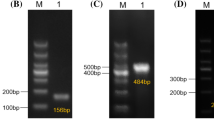Abstract
Multiplex PCR–CE–SSCP approach was used to identify foodborne pathogens. 16srRNA system including three target fragments localized at different position of 16srRNA gene and gyrB system including two target fragments at gyrB gene were established. SSCP profile was analyzed in a similar way as RAPD and the identity of each peak was determined by relative position to inner standard. Twenty-five reference bacteria strains representing 2 classes, 12 genus and 19 species were tested. All bacteria could be distinctly determined at genus level by 16srRNA system. GyrB system improved discriminating resolution of some bacterial at species level. Phylogenetic analysis showed that 16srRNA based phylogenetic relationship was consistent with traditional classification of these organisms. Good reproducibility and resolution make multiplex PCR–CE–SSCP protocol a promising approach for fast screening of foodborne pathogens.




Similar content being viewed by others
References
Armstrong J, Gibbs A, Peakall R, Weiller GF (1994) Computer program distributed by the Australian National University. http://life.anu.edu.au/molecular/software/rapd.html
Case RJ, Boucher Y, Dahllo I, Holmström C, Doolittle WF, Kjelleberg S (2007) Appl Environ Microbiol 73(1):278–288
Chung JH, Park YS, Kim J, Shin GW, Min-KyuOh MHN, Kim CW, Jung GY, Park JH (2007) Electrophoresis 28:2416–2423
Fitz-Gibbon ST, House CH (1999) Nucleic Acids Res 27:4218–4222
Gurtler V, Mayall BC (2001) Int J Syst Evol Microbiol 51:3–16
Hong H, Pruden A, Reardon KF (2007) J Microbiol Meth 69:52–64
Ip M, Chau SSL, Chi F, Qi A, Lai RWM (2006) J Clin Microbiol 44(3):970–975
Jain R, Rivera MC, Lake JA (1999) Proc Natl Acad Sci USA 96:3801–3806
Nair S, Lin TK, Pang T, Altwegg M (2002) J Clin Microbiol 40(7):2346–2351
Orita M, Iwahara H, Kanazawa H, Hayashi K, Sekiya T (1989) Proc Natl Acad Sci USA 86:2766–2770
Rivera MC, Jain R, Moore JE, Lake JA (1998) Proc Natl Acad Sci USA 95:6239–6244
Siefex JL, Fox GE (1998) Microbiology 144:2803–2808
Widjojoatmodjo MN, Fluit ADC, Verhoef J (1995) J Clin Microbiol 33(10):2601–2606
Acknowledgments
This study was funded by General Administration of Quality Supervision, Inspection and Quarantine (AQSIQ), People’s Republic of China (2007IK180) and the Eleventh 5-year Plan project of the Ministry of Science and Technology, People’s Republic of China (2006BAD05A06-Z02).
Author information
Authors and Affiliations
Corresponding author
Rights and permissions
About this article
Cite this article
Wu, Y., Chen, Y., Zhu, C. et al. Multiplex PCR–capillary electrophoresis–SSCP used to identify foodborne pathogens. Eur Food Res Technol 228, 511–518 (2009). https://doi.org/10.1007/s00217-008-0958-z
Received:
Revised:
Accepted:
Published:
Issue Date:
DOI: https://doi.org/10.1007/s00217-008-0958-z




